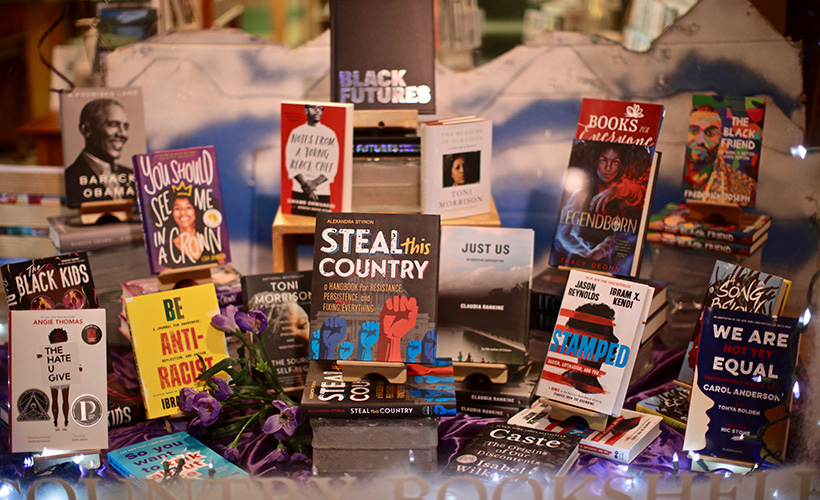All around the world, many librarians are striving to build ever more inclusive, diverse, and representational collections for their library users. Focus is being put on interrogating past practices and “traditional” library collection development strategies and policies for bias or exclusion, making changes to ensure collection building is now done with a goal of greater representation of perspectives and experiences from both a library’s local and global communities, and generally working to embrace Dr. Rudine Sims Bishop’s call for the importance of access to books that provide “Windows, Mirrors, and Sliding Glass Doors” (Bishop, 1990).
However, even when librarians intentionally work to disrupt and counter biases during the acquisitions and collection development process, and have succeeded in developing a beautifully inclusive collection full of excellent resources by and about Black people, Indigenous people, People of Color, Disabled people, Queer people, and members of other systemically excluded communities, we may yet find that some of these incredible resources may not, initially, circulate as often as we expected. Sadly, what we will find is that many of these incredible resources will not have received the same level of marketing and “name recognition” (yet) that many of the resources written by (and often about) white, straight, cis people often enjoy.
Fortunately, although a lack of big publisher marketing campaigns and/or “name recognition” is certainly one thing that can impact a resource’s likelihood to circulate, it is not the only consideration. There are, in fact, many actions librarians can take to help market and display resources to help ensure these resources in our inclusive collections get noticed, discovered, and circulated by library users who will need or enjoy them. Some of my most successful strategies include:
1. Leverage Your Front-Facing & Display Space to Amplify Diverse Representation
If you’ve ever gone into a bookstore, you’ve likely noticed how much effort they put into having as many book covers showing as possible (as opposed to rows of spines). This is because people really do “judge a book by its cover,” and seeing the cover art really does help market books to potential readers—which, of course, in a library, results in higher circulation for those resources. For this reason, I recommend libraries work on establishing as much front-facing and display space in the library as possible; rows of spines are a missed opportunity to market resources.
I also recommend that librarians and library workers seek to be very intentional in selecting which books get featured on displays and as front-facing books. We can (and should) choose to use displays and front-facing as opportunities to help market and amplify books written by Black people, Indigenous people, People of Color, Disabled people, Queer people, and members of other systemically excluded communities as often as we can. This is especially important when those resources have less “name recognition” or did not receive as much marketing and publicizing as they deserve.

While it may seem natural to choose the latest release from one of the “Big Name” authors to display or front-face, I would encourage librarians and library to consider whether that strategy merely helps hold the status quo in place and continues to relegate many other perspectives, voices, and experiences to the margins. Every single item selected for highlighting, front-facing, or display is an opportunity for us to build a fairer and more inclusive library experience and environment for our patrons, and we should take as many of those opportunities as possible to amplify and center systemically excluded communities, voices, perspectives, and narratives.
2. Diverse Representation in Everything, EVERY Time
Every single choice librarians and library workers make regarding library resources, policy, programming, etc., is an opportunity to move the library toward greater inclusivity and representation. This means that every single display, book list, social media post, book talk session, informal recommendation, purchase, decoration, program, etc., can be intentionally and actively making it more inclusive and diverse. This is why the practice of ongoing informal diversity audits in all realms of our professional efforts are an important habit to develop.
Every time we choose several resources for a display, a social media post, your summer reading book list, etc., we should be pausing and auditing to ensure they’re inclusive and diverse in representation. Every program and policy we develop should be analyzed to ensure it’s representational, culturally relevant, and culturally sensitive. Every time a patron asks us for book recommendations, we should be mindful and intentional in ensuring we are not always only recommending resources by or about a single perspective, voice, or experience. This practice of intentional, active inclusion is something that can and should be applied to every choice made in or for the library. This is how we build inclusive library experiences and environments—by always keeping this goal at the forefront of our decision making.
3. In Book Talks, Go Beyond the Existence of a Book’s Diverse Representation
One of the best ways to market a book is to book talk it. Book talking is usually a short talk about a specific book with the goal of convincing someone else to check it out and read it. When librarians give book talks, we usually try to “hook” the reader by giving them a small taste of what the book is about and/or what makes it particularly engaging or engrossing. We might provide a teaser, a quote, or otherwise provide an introduction to the book’s vibe, tone, characterization, pace, themes, etc.
When book talking books by or about Black people, Indigenous people, People of Color, Disabled people, Queer people, or members of other systemically excluded communities, the book talker may be tempted to book talk the book as a “diverse book.” This isn’t necessarily a bad thing, but book talkers need to make sure they aren’t only focusing on the fact of a book’s “diversity” or representation when book talking it. We must focus on what makes the book great; we must book talk a book by or about Black people, Indigenous people, People of Color, Disabled people, Queer people, or members of other systemically excluded communities in the same way we book talk books by and about white, straight, and cis people.
If someone asked for a great horror book, we would never choose Stephen King’s It and merely book talk it by saying, “This is a great one, the author is white!” or “Oh, this is a good one if you’re looking for a book with a straight main character.” Right? Of course we would not, because those facts don’t really tell the reader anything about the book or why they might like the book. If we wouldn’t book talk a book with straight, white, or cis representation by focusing only on the representation, then of course we also should not book talk books written by or about Black people, Indigenous people, People of Color, Disabled people, Queer people, or members of other systemically excluded communities in such a narrow and limiting way either. Focusing solely on a book’s representation is not doing justice to these incredible stories, so I encourage book talkers to always focus book talks on what makes the story great, engaging, engrossing, alluring, enjoyable, etc.
Remember that purchasing diversely and building an inclusive collection is only the first step. If all of those wonderful stories written by and about Black people, Indigenous people, People of Color, Disabled people, Queer people, or members of other systemically excluded communities sit on the shelves collecting dust, that isn’t a successful inclusive library collection. Active and intentional marketing is necessary to ensure our patrons are able to fully enjoy and engage with diverse stories, perspectives, and voices via “Windows, Mirrors, and Sliding Glass Doors” (Bishop, 1990).
*Citation: Bishop, R. S. (1990). Mirrors, windows, and sliding glass doors. Perspectives, 6(3), ix–xi.
See also:


